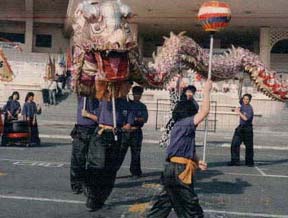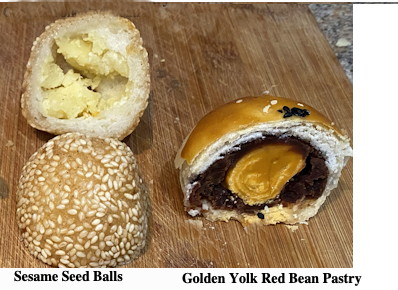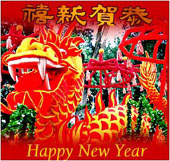The Lunar New Year Festival is the
most significant holiday for Asian people around the world, regardless
of the origin of their ancestors.
Celebration
Lunar New Year celebration starts with the New Moon on the first day of the new year and ends on the full moon 15 days later.
Most of the celebrating takes place on New Year's Eve and New Year's Day (day 1), and is traditionally a time for family, reunion and rejoicing.
The presence of the ancestors is acknowledged on New Year's Eve with a dinner arranged for them at the family banquet table. The spirits of the ancestors, together with the living, celebrate the onset of the New Year as one great community. The communal feast called "surrounding the stove" or weilu. It symbolizes family unity and honors the past and present generations.
It is called teen nien fan (in Cantonese) and it refers to the Chinese reunion dinner.
On New Years day itself is for gift giving (see Gifts below)
The third and fourth days are for the sons-in-laws to pay respect to their parents-in-law.
The 10th through the 12th are days that friends and relatives should be invited for dinner.
The 14th day should be for preparations to celebrate the Lantern Festival which is to be held on the 15th night.
15th day - Lantern Festival - people carried lanterns into the streets to take part in a great parade and folk dancing.
A special feature of the Lantern Festival is the dragon dance, where a huge dragon head and body, supported by a team of young dancers weaves its way around the streets collecting money on its route.
Usually held on Saturday in America.
A lion dance is also popular and may be held anytime during the 15 day celebration.
The New Year season extends from the mid-twelfth month of the previous year to the middle of the first month of the new year.
Food
Traditional Meal consists of:
fish (yu) represent "having enough to spare".
A whole fish represents togetherness and abundance.
A chicken for prosperity. The chicken must be presented with a head, tail and feet to symbolize completeness.
A vegetarian dish called jai. ingredients in jai are root vegetables or fibrous vegetables.
zong zi (glutinous rice wrapped up in reed leaves).
See more about food below.
Gifts
On New Years day itself, an ancient custom called Hong Bao (Red Packet) takes place.
Children wake up early to find small red envelopes containing sweets or money under their pillows and married couples give unmarried adults small packets of money and then the new year greetings begin. children are given Red Lai-See Envelopes , good luck money wrapped in little red envelope
A month before the New Year is a good time for business. People buy presents, decoration material, food, and clothing
Rituals, Superstitions
The Eve of the New Year is carefully observed. Supper is a feast. Every light is supposed to be kept on the entire night. On the stroke of midnight on New Year's Eve, every door and window in the house have to be open to allow the old year to go out.
At midnight, the whole sky is emblazoned with fireworks, and the streets with firecrackers.
The use of firecracker's and fireworks on new year eve is based on the ancient Chinese belief that humans may be devoured by the "Nian" animal spirit around this time of the year. Thunder frightens off the spirit, and so people use firecracker's to simulate this sound.
In addition, red-paper couplets are pasted on doors and torches are lit, because Nien is said to fear the color red, the light of fire, and loud noises. Early the next morning, as feelings of triumph and renewal fill the air at successfully keeping Nien away for another year, the most popular greeting heard is kung-hsi (gong si) ®¥3ß, or "congratulations."
There is a spiritual aspect to the celebration, and all of Taiwan's temples are usually
very busy during this time of year as large numbers of people crowd into
them with elevated incense sticks to pray for good luck. Indeed, some
of the major temples close their main gates before midnight on Chinese
New Year's Eve as noisy and expectant crowds gather outside. At the stroke
of midnight, the doors are thrown wide open and people surge forward in
an attempt to be the first to place their incense sticks into the censer,
as another long-standing tradition states that the first person to do
so will be blessed with good luck throughout the coming year.
 Dragon Dance:
Dragon Dance:
The dragon dance is an important festive tradition in China. It was originally performed to please the dragon, who is the deity of water, to ask for rain during drought years. Gradually it became an entertainment and dance form in festive occasions.
Chinese people consider themselves descendents of dragon, which is in fact, a fictitious
animal combining some features of a deer, fish, tiger, lion, horse, ox, donkey, snake and
vulture. The divine artificial animal is always associated with clouds, thunderbolts and
rainfalls. It can walk on the land, swim in the sea and fly in the air and is the deity of wind
and rain.
 Chinese people believe it is mascot and embodiment of power, dignity, luck,
strength and success. Chinese emperors proclaimed they were incarnations of the real
dragons to assure their superior authority. Chinese people believe it is mascot and embodiment of power, dignity, luck,
strength and success. Chinese emperors proclaimed they were incarnations of the real
dragons to assure their superior authority.
The Lion Dance was originally used for worship
and to pray for rain.
Cleaning and Washing hair
Cleaning a house on New Year's day runs the risk of washing or sweeping away good luck.
For the same reason, washing hair is avoided on the first and last day of the New Year.
Calendar
 The Chinese calendar is based on a combination of lunar and solar movements. The lunar cycle is about 29.5 days. In order to "catch up" with the solar calendar the Chinese insert an extra month once every few years (seven years out of a 19-yearcycle). This is the same as adding an extra day on leap year.
Solar calendar dates for New Years vary from as early as January 21st to as late as February 19th.
The Chinese calendar is based on a combination of lunar and solar movements. The lunar cycle is about 29.5 days. In order to "catch up" with the solar calendar the Chinese insert an extra month once every few years (seven years out of a 19-yearcycle). This is the same as adding an extra day on leap year.
Solar calendar dates for New Years vary from as early as January 21st to as late as February 19th.
The Chinese animal signs are a 12-year cycle used for dating the years. They represent a cyclical concept of time, rather than the Western linear concept of time.
Chinese legend states that thousands of years ago, Buddha summoned all the animals in the kingdom. Only twelve animals answered his call. As a reward, Buddha endowed each animal with a year of its own in the order of arrival. From then on, each year of the Chinese calendar bore the characteristics of the animal of that name.
A cultural sidelight of the animal signs in Chinese folklore is that horoscopes have developed around the animal signs, much like monthly horoscopes in the West have been developed for the different moon signs, Pisces, Aries, etc. For example, a Chinese horoscope may predict that a person born in the Year of the Horse would be, "cheerful, popular, and loves to compliment others". These horoscopes are amusing, but not regarded seriously by most people.
See: Chinese Calendar
| Animal | Chr | Gregorian Year | 200x
Date | Chinese
Year * |
| 1 | 2 | 3 |
| Rat |  |  |  | 1936,1948,1960,1972,1984,1996 | Feb 7, 2008 | 4705 |
| Ox |  |  |  | 1937,1949,1961,1973,1985,1997 | Jan 26, 2009 | 4706 |
| Tiger |  |  |  | 1938,1950,1962,1974,1986,1998 | Feb 14, 2010 | 4707 |
| Rabbit/Hare |  |  |  | 1939,1951,1963,1975,1987,1999 | Feb 3, 2011 | 4708 |
| Dragon |  |  |  | 1940,1952,1964,1976,1988,2000 | Jan 23, 2012 | 4709 |
| Snake |  |  |  | 1941,1953,1965,1977,1989,2001 | Feb 10, 2013 | 4710 |
| Horse |  |  |  | 1942,1954,1966,1978,1990,2002 | Jan 31, 2014 | 4711 |
Sheep/Ram
goat |  |  |  | 1943,1955,1967,1979,1991,2003, | | |
| Monkey |  |  |  | 1944,1956,1968,1980,1992,2004 | Jan 22, 2004 | 4701 |
| Rooster/Cock |  |  |  | 1945,1957,1969,1981,1993,2005 | Feb 9, 2005 | 4702 |
| Dog |  |  |  | 1946,1958,1970,1982,1994,2006 | Jan 29, 2006 | 4703 |
| Boar/Pig |  |  |  | 1947,1959,1971,1983,1995,2007 | Feb 18, 2007 | 4704 |
* Chinese year for current calendar
Some systems add 1 to the year above.
1. Symbol for animal (a memory jogger).
2. Sequence for earthly (terrestrial) position.
3. This is a stylized pictorial style font for the animal names.
The actual year is a combination of 10 Celestial Stemms and 12 Terrestrial Branch (animals),
so you will see two character designations for specific years. These combinations cycle. See Calendar.
The 12 year cycle begins with the Rat. According to Chinese legend, the twelve animals quarreled one day as to who was to head the cycle of years. The gods were asked to decide and they held a contest: whoever was to reach the opposite bank of the river would be first, and the rest of the animals would receive their years according to their finish.
All the twelve animals gathered at the river bank and jumped in. Unknown to the ox, the rat had jumped upon his back. As the ox was about to jump ashore, the rat jumped off the ox's back, and won the race.
See: Chinese Calendar
Food:
 Traditional Chinese New Year Foods to Ring in the Year Traditional Chinese New Year Foods to Ring in the Year
Eating Fish
Don't turn over the fish after eating the uppermost side as turning the fish is regarded as a bad omen, signifying a capsized boat.
In Chinese Customs And Taboos, a book published by Penerbit Fajar Bakti Sdn Bhd, author Ann Wan Seng says that "when eating fish during Lunar New Year, the fish bone must remain intact. It is believed that if the fish bone is broken, the diners' luck and blessings will break, too."
Ann confirms the fishermen's superstition about eating fish: that the flesh on the underside must not be eaten or the fishing vessel may keel over and sink!
Chicken Head
Workers too gather for a pre-festive meal to commemorate "the last day of work" before the festive holidays.
In the early days, having a chicken for a meal was an honour. Chicken was only served on grand occasions and festivals. And if the employer wanted to fire a worker, he could send a strong message by the way he positioned the chicken head.
"If the chicken head faced the worker, he would know that trouble was brewing," says Shek.
"And if the boss passed him the chicken head, he would know that after finishing the meal, he must look for another job.
"Therefore, the chicken dish was called mo ching kai or unsympathetic chicken as it was used as a means to dismiss an employee.
Other Food
Many of the dishes made at this time are
served because they are regarded as symbols of good luck. For instance,
fish (yu) represent "having enough to spare," garlic chives (chiu-tsai)
stand for "everlasting," turnips (tsai tou) mean "good omens,"
and fish balls (yu-wan) and meat balls (jou-wan) represent
"reunion." Auspicious refreshments are also prepared at this time, such
as glutinous rice flour pudding (nien-kao), which is said to make
people "advance toward higher positions and prosperity step by step."
People from northern China usually have dumplings (shui-chiao)
too, which look like shoe-shaped gold and are supposed to help those who
eat them to amass fortunes and wealth.
Pastres:


Lunar New Year Nan Gao Brown Sugar Rice Cake - Lisa Lin
In addition to the traditional brown sugar variety, nian gao comes in various flavors such as coconut, red bean, taro, ground peanuts, or ground pitted jujubes. While they are typically made in a round shape, they can also be molded into shapes like koi fish or gold bars. The nian gao can either be garnished with jujubes or with a sticker with the Chinese character.
Links:
Largest Chinatowns
Lunar New Year at Taiwan Government Web
last updated 3 Jan 2007
|
|
 Cultures
Cultures Cultures
Cultures
 Gong Xi Fa Cai
Gong Xi Fa Cai